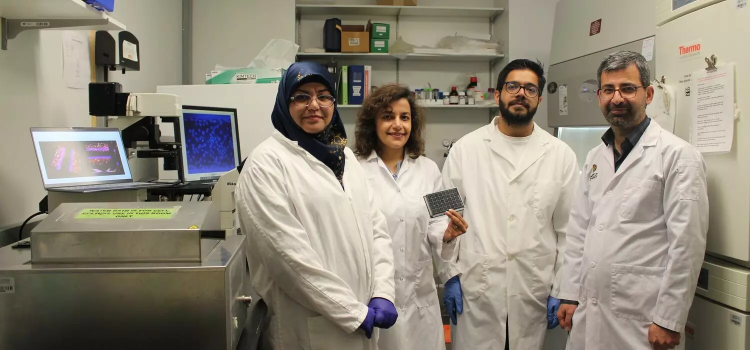A team of University of Calgary researchers is calling it a game-changer for understanding gut health.
It has been working on improving 3D models of the human intestine to create more-realistic experiments and tests to help diagnose and treat gastrointestinal issues. Using patient-derived organoids, which are akin to mini-guts, enabled the team to more accurately replicate the internal environment of an intestine on a new gut-on-a-chip platform.

From left: Maryam Vatani, Bahareh Zarin, Sorosh Abdollahi, Amir Sanati Nezhad Joe McFarland
While the technology to grow organoids from patient tissues has been around since 2012, researchers continue to look at how it can be made more efficient and accurate to account for an individual's unique body characteristics.
"This isn't just a model of the gut, this is a living, human-relevant system," says Dr. Amir Sanati Nezhad, PhD, the project's lead investigator.
"We've engineered it for speed, scalability, and biological relevance, which changes everything for drug development, safety screening, and disease research."
He says the team's findings, "Biomimetic culture substrates for modelling homeostatic intestinal epithelium in vitro" recently published in Nature Communications, open the door to new research on diseases of the gut and other parts of the body.
A variety of applications
About the size of a USB memory stick, the gut-on-a-chip utilizes tiny amounts of liquid to create a realistic model of an intestine. The chip is used in a variety of settings, including real-time monitoring of cell behaviours, and it supports research into conditions such as inflammatory bowel disease and colorectal cancer.
Drug developers and other researchers can use it to evaluate pharmaceuticals, personal-care products and how food additives interact with the gut.
Sanati Nezhad explains the device puts cells into a simulated microenvironment.
"The chip reproduces key features of the intestine - barrier function, mucus layer, nutrition update, immune signals - making it ideal for evaluating how the gut responds to real-world exposures," says the Department of Biomedical Engineering professor.
Gateway to future research
Most gut models in use currently require between two and four weeks to become fully functional.
But Sanati Nezhad says his team's system can become functional in three days, significantly reducing the risk of cross-contamination, or cells and tissues dying. Researchers can start using the model sooner, instead of spending time waiting for it to be ready.
"This breakthrough saves critical time and enables real-time testing of chemicals, drugs and pathogens," he says.
Not only is the gut-on-a-chip faster, but the report's authors say it's also smarter than current alternatives, as it is automated, allowing for simultaneous testing of multiple conditions or compounds, supporting faster drug screening and toxicology workflows.
"This is a leap forward in gut modelling," says Schulich PhD student Sorosh Abdollahi, the first author of the story. "It combines biological accuracy with practical speed, enabling a whole new range of applications in health and disease research."
He says that includes how the gut communicates with organs like the brain and liver, making the technology a gateway for exploring how gut disruptions may drive neurodegeneration, immune disorders, and cancer.
The Human Organoid Innovation Hub within the Snyder Institute for Chronic Diseases at the Cumming School of Medicine provided the team with patient-derived organoids for this study. The Hub is co-directed by Dr. Simon Hirota, PhD.
Dr. Amir Sanati Nezhad is a professor at the Schulich School of Engineering and a member of the Hotchkiss Brain Institute, the Calvin, Phoebe and Joan Snyder Institute for Chronic Diseases, and the Arnie Charbonneau Cancer Institute at the Cumming School of Medicine.
The University of Calgary's multidisciplinary Engineering Solutions for Health: Biomedical Engineering research strategy drives innovations that are saving lives and revolutionizing health care for Canadians. With collaborative teams focused on human mobility, health monitoring, advanced biomedical imaging, precision biodiagnostics, regenerative medicine and novel medical technologies, our researchers are transforming quality of life and continuously improving the health system.












